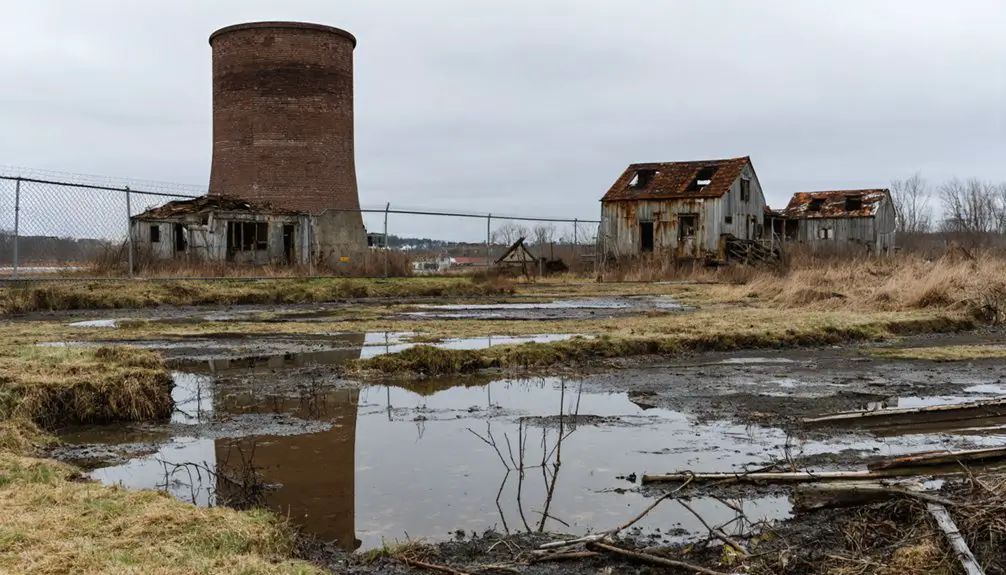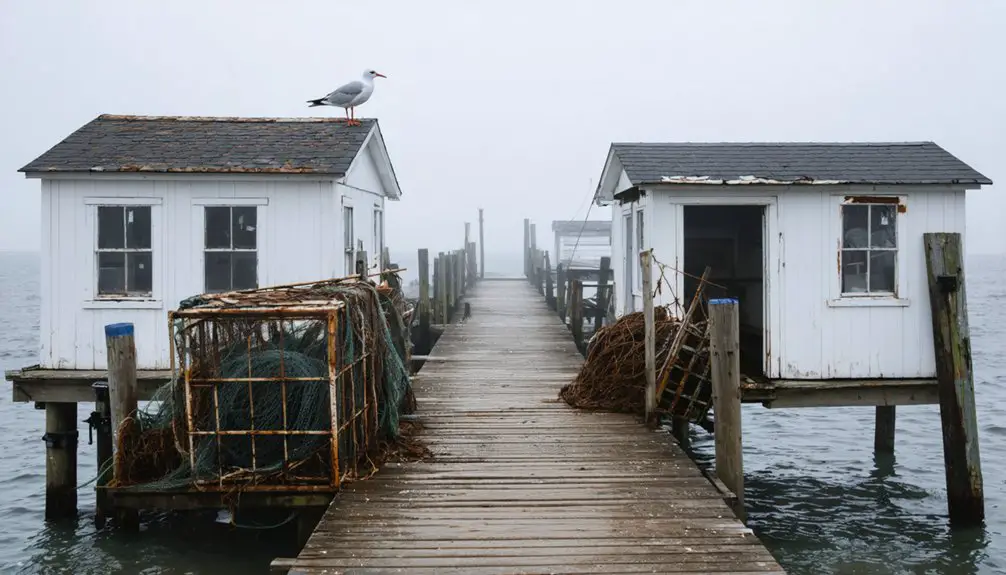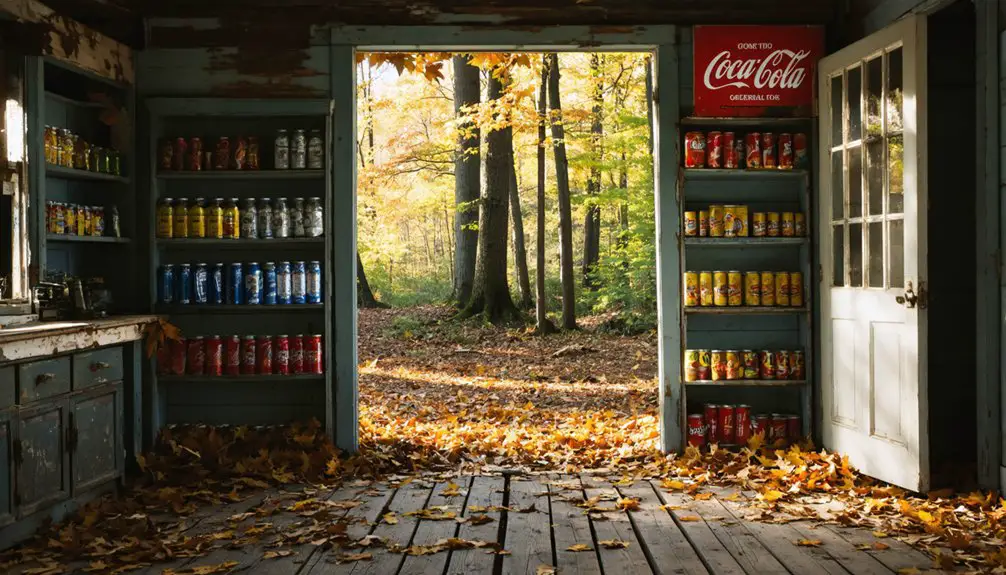You’ll find Ligonia Village‘s ghost town remnants in South Portland, Maine, where a vibrant Irish immigrant community once thrived around Portland Rolling Mills in the mid-1800s. The village centered on Ligonia Hall, built by Henry Bodge in 1866, which hosted cultural events and community gatherings. Today, only Calvary Cemetery and industrial sites mark where this close-knit community lived and worked. Their story reveals how economic forces and transportation changes can transform a thriving settlement into memory.
Key Takeaways
- Ligonia Village transformed from a thriving Irish immigrant community centered around Portland Rolling Mills into an abandoned industrial site.
- The mid-20th century decline of Portland Rolling Mills triggered widespread job losses and population exodus from the village.
- Modern visitors find only Calvary Cemetery and oil companies where the original Irish immigrant settlement once stood.
- Decreased rail service isolated the community, while Ligonia Hall’s diminishing role signaled the village’s social fragmentation.
- Historical records, including newspapers and cemetery records, are the primary remaining evidence of this ghost town’s former vibrant existence.
A Village Born From Irish Roots
When Irish immigrants began settling in Ligonia Village during the mid-1800s, they established a community that would become intrinsically linked to Portland Rolling Mills’ industrial operations.
You’ll find their story deeply rooted in western Ireland, particularly County Galway, where many of these families originated, bringing their Irish traditions across the Atlantic during waves of migration intensified by the Great Famine. These workers found steady employment at the Portland Rolling Mills, which formed the economic backbone of the village.
Through chain migration, these determined settlers helped family members join them in Maine, creating a tight-knit community that preserved their cultural heritage while adapting to their new home. The area’s complex land ownership history traced back to when Massachusetts claimed jurisdiction over the disputed Maine territory in 1652.
The cultural integration process saw Irish Catholic communities flourish along Maine’s coast, with immigrants building support networks that would sustain them through challenging industrial work and discrimination, ultimately shaping Ligonia Village’s distinctive character.
The Rise of Portland Rolling Mills
As Portland’s industrial landscape evolved in the late 19th century, the Portland Rolling Mills emerged as a cornerstone of the region’s manufacturing might.
You’d find companies like Bancroft & Martin Rolling Mills Co. at the heart of this industrial expansion, transforming raw steel into essential products that built your community’s infrastructure. Their specialized expertise extended to collaborating with John Howard Stevens on major warehouse projects in the early 1900s.
The area’s industrial heritage traced back to the South Portland Planing Mill, which operated into the 1960s as a crucial part of the local lumber industry.
Life in a 19th Century Company Town
Your daily routine in Ligonia Village revolved entirely around the Portland Rolling Mills’ demanding schedule, with work shifts dictating when you’d wake, eat, and rest. The company-owned shops maintained high prices while limiting workers’ ability to shop elsewhere.
You’d find support through your ethnic community’s mutual aid societies and cultural organizations, which helped families cope with workplace injuries, illnesses, or sudden unemployment. Similar to other Maine towns, the community maintained its vitality through small local industries despite economic pressures of the era.
Despite company restrictions on social gatherings, you’d strengthen community bonds through shared activities at the company-sanctioned recreation facilities, including the bandstand and bowling green.
Daily Worker Routines
Life in Ligonia Village revolved around the relentless demands of industrial labor, where workers faced strictly regimented schedules that began at dawn and stretched into the evening hours.
You’d find yourself adapting to the constant hum of machinery, while your daily labor required unwavering attention and skill development throughout long shifts. The lack of political representation in these company-controlled communities often led to widespread worker frustration.
Your entire existence centered on the company’s control. You’d purchase necessities at inflated prices from the company store using scrip instead of real wages, while living in company-owned housing where rent was automatically deducted from your pay.
Your children might work alongside you, handling simpler tasks to supplement the family’s income. Women in your household would balance domestic duties with home-based piecework, while men spent their days operating industrial equipment.
The company’s influence extended beyond work, shaping every aspect of your daily routines. During times of economic hardship, many families relied on rural self-sufficiency by growing their own food and preserving it through canning.
Community Support Networks
While the company maintained strict control over daily life, residents of Ligonia Village created informal support networks that helped them navigate the challenges of industrial living.
You’d find immigrant and African American families forming tight-knit groups, establishing their own cultural institutions and fraternal organizations to preserve their heritage and build community resilience.
Despite segregated facilities, these networks fostered social solidarity through shared experiences and mutual aid.
In response to economic vulnerability, workers developed cooperative systems to help each other during hardships.
Like the historic Pullman labor strike that united workers against unfair practices, Ligonia Village residents learned to stand together when facing adversity.
When facing the company store’s high prices or wage advances that led to debt, neighbors would pool resources and share essential items.
Through these grassroots support systems, residents found ways to maintain dignity and some measure of independence within the constraints of company control.
The establishment of welfare management programs by companies aimed to address social reform pressures while maintaining control over worker communities.
Henry Bodge and the Heart of Community
When Henry Bodge constructed Ligonia Hall in 1866-1867, you’d have found yourself at the epicenter of village social life, where two ground-floor shops supported a grand meeting space above.
You could’ve attended the hall’s dedication in February 1867, joining Good Templars lodge members who gathered for speeches and singing as part of the 145-strong fraternal organization.
As Ligonia’s primary gathering place, you’d have witnessed the hall host everything from political rallies to social functions, providing the mainly Irish working-class community a space to strengthen their collective bonds and engage in civic discourse.
Building Ligonia Hall’s Legacy
Through the dedicated leadership of Henry Bodge, Ligonia Hall emerged as the beating heart of 19th-century village life in Ligonia, Maine.
You’ll find his vision woven into every aspect of the hall’s legacy, from its role as a cultural preservation center to its function as a cornerstone of community identity. Bodge transformed the space into more than just a meeting house – it became a dynamic center for social reform, education, and historical documentation.
You can trace his influence in the hall’s diverse programming, which included temperance meetings, labor rights discussions, and exhibitions of local artifacts.
Under his guidance, the venue hosted everything from serious civic debates to cultural celebrations, establishing itself as both a guardian of tradition and a catalyst for progressive change in Maine’s evolving social landscape.
Community Hub and Politics
A powerhouse of local influence, Henry Bodge shaped Ligonia’s political and social landscape through his strategic land acquisitions and reform-minded leadership.
You’ll find his impact throughout the village’s community governance, from his Main Street developments to his progressive stance on labor rights.
His political influence expanded through key reforms that transformed Ligonia:
- Challenged traditional workplace alcohol practices by opposing employer-provided liquor
- Advocated abolishing the bell system that signaled workers’ drinking times
- Collaborated with Hon. William W. Thomas on civic initiatives
- Established essential commercial properties that strengthened the town’s economy
As a trusted leader during crises and a champion of public order, Bodge’s vision helped Ligonia evolve from farmland into a structured village with thriving social and commercial spaces.
Hosting Local Social Groups
The bustling Ligonia Hall, built by Henry Bodge in 1866, stood as the village’s premier social hub, featuring two ground-floor stores and a grand hall above for community gatherings.
You’d find the Ligonia Lodge of Good Templars, 145 members strong, leading the charge for temperance reform while fostering social cohesion through their regular meetings.
The hall’s strategic location on Main Street near Lincoln Street made it the perfect venue for community engagement. You could attend public speeches, enjoy cultural events with singing, or participate in fraternal organization meetings.
Bodge’s vision for the space went beyond mere entertainment – it became a catalyst for civic discourse and social progress. The hall’s quality finish and flexible scheduling meant you’d always find a warm welcome, whether for recreation or reform.
Transportation Networks and Economic Growth
During Maine’s early industrial expansion, transformative transportation networks radically shaped Ligonia Village’s economic trajectory. The arrival of rail and electric trolley systems revolutionized local commerce, connecting Ligonia to Portland’s bustling industrial core and regional trade networks.
You’ll find that transportation history directly influenced Ligonia’s economic impact through:
- Strategic positioning along Main Street and near the Sprague terminal
- Access to Portland’s harbor industries and coal shipping facilities
- Connection to the Portland-Lewiston Interurban Railroad system
- Integration with regional foundries and machine shops
These crucial transportation links fostered industrial growth, supporting metalworking businesses, canneries, and other manufacturing ventures.
The area’s accessibility via road and rail created opportunities for workers and entrepreneurs, though these advantages would eventually fade as transportation patterns shifted in later decades.
The Slow Fade of a Thriving Settlement

Once prosperous and bustling with Irish immigrant families, Ligonia Village’s decline emerged through a complex interplay of economic and social forces in the mid-20th century.
You’ll find the story of Ligonia’s fade echoes many northeastern mill towns, where economic shifts dismantled the foundations of thriving communities. The Portland Rolling Mills’ downturn triggered a cascade of changes – as jobs disappeared, younger residents sought opportunities elsewhere, weakening the village’s social fabric.
The decline of rail service isolated the community further, while Ligonia Hall’s diminishing role as a gathering place signaled the community’s fragmentation.
Today, you’ll barely recognize the original village, as Calvary Cemetery and oil facilities have claimed much of the land where this vibrant Irish immigrant community once flourished.
Modern Remnants and Lost Heritage
Modern visitors to Ligonia Village‘s former site will find precious little evidence of the vibrant Irish immigrant community that once called this area home.
Today, Calvary Cemetery occupies most of the original settlement, while oil companies have claimed adjacent parcels, erasing nearly all physical traces of this once-thriving community.
The village’s cultural continuity lives on primarily through:
- Historical newspaper archives detailing community events
- Lodge records documenting social gatherings at Ligonia Hall
- Cemetery records preserving former residents’ names
- Oral histories passed down through generations
Memory preservation remains challenging, as no major archaeological studies have explored the site.
You’ll find no standing structures from the original village, and the railway spur that once connected Ligonia to Portland has vanished beneath modern development, leaving only written accounts to tell the story of this lost Maine settlement.
Industrial Legacy in South Portland

South Portland’s industrial might emerged most prominently through its World War II shipbuilding operations, when the New England Shipbuilding Corporation produced an astounding 236 Liberty ships – more than 10% of America’s total wartime fleet.
The city’s industrial transformation extended far beyond shipbuilding. You’ll find its maritime heritage preserved in the massive petroleum storage tanks that line the shoreline, a representation of South Portland’s century-long role as Maine’s primary oil gateway.
The post-war era brought new ventures like the South Portland Planing Mill, processing 100,000 board feet of lumber daily. The railroad’s presence at Thompson’s Point, with its historic Machine Shop, further shaped the industrial landscape.
Today, while many original structures are gone, creative redevelopment projects like Brick South honor this working-class legacy.
Lessons From Maine’s Ghost Communities
While South Portland’s industrial growth tells a story of expansion, Maine’s ghost communities reveal the opposite trajectory – teaching valuable lessons about the impermanence of human settlements.
These abandoned places showcase remarkable patterns of cultural resilience and demographic shifts that you’ll recognize in today’s changing communities.
Maine’s ghost towns demonstrate four critical lessons:
- Communities dependent on single industries often struggle to survive economic shifts.
- Environmental changes, whether natural or human-made, can force permanent relocations.
- Transportation infrastructure dramatically impacts a town’s long-term viability.
- Population patterns follow broader societal changes, from wartime disruptions to urban migration.
Understanding these patterns helps you grasp how modern communities might adapt to similar challenges, ensuring today’s towns don’t become tomorrow’s abandoned settlements.
Frequently Asked Questions
What Were the Average Wages at Portland Rolling Mills?
You’d find Portland Rolling Mills’ wage history aligned with Maine’s industrial labor rates, paying workers approximately $17-22 per hour, or $45,000 annually, following state-mandated increases and union negotiations.
Did Any Major Accidents or Disasters Occur in Ligonia Village?
Despite a bustling industrial zone with over 200 workers, you won’t find records of major tragic events in the archives. Historical safety records show no documented disasters or significant accidents affecting the community.
What Happened to the Families Who Left Ligonia?
Most families moved to Portland during this economic-driven family migration, where you’d find them seeking work opportunities. They joined established Irish communities and found jobs in larger industrial operations.
Were There Any Schools or Churches in Ligonia Village?
You won’t find clear evidence of schools or churches in historical records. While Ligonia Hall served as the community’s gathering space, residents likely attended schools and religious services in nearby Portland or South Portland.
What Native American Tribes Originally Inhabited the Ligonia Area?
Like threads in a tapestry, the Almouchiquois tribal bands were your area’s first inhabitants, belonging to the broader Wabanaki Confederacy, alongside neighboring Penobscot and Passamaquoddy peoples who influenced the region’s Native American history.
References
- https://newenglandwithlove.com/ghost-towns-in-maine/
- https://newenglandhistoricalsociety.com/six-new-england-ghost-towns/
- https://nz.hotels.com/go/usa/ghost-towns-maine
- https://www.pressherald.com/2023/12/06/a-window-on-the-past-henry-bodge-of-ligonia/
- https://en.wikipedia.org/wiki/List_of_ghost_towns_in_Maine
- https://portsmouthathenaeum.org/message-from-a-lost-colony/
- https://www.mainememory.net/sitebuilder/site/1124/display
- https://www.youtube.com/watch?v=1oubTvLqn7M
- https://www.pressherald.com/2022/06/09/a-window-on-the-past-the-broadway-plate-yard-and-south-portland-planing-mill/
- https://digitalcommons.usm.maine.edu/cgi/viewcontent.cgi?article=1288&context=cbep-publications



